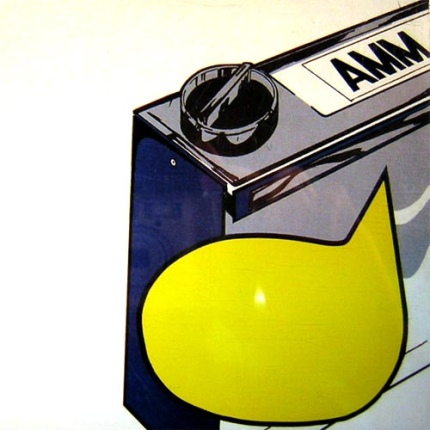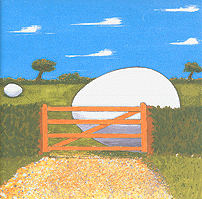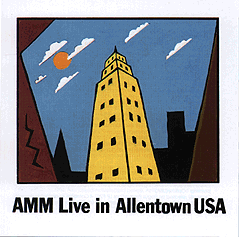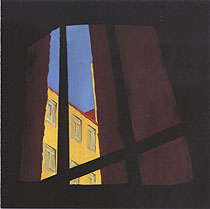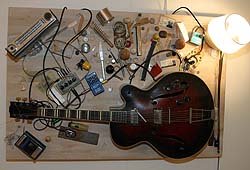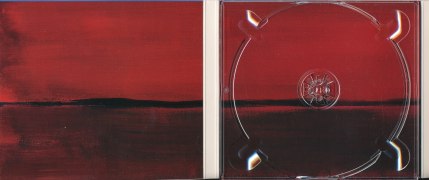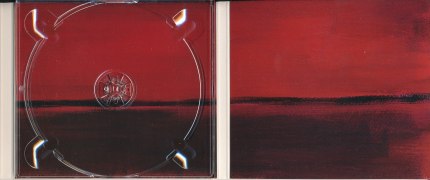While Keith Rowe is a very different artist from Peter Brötzmann, they both started under strategically comparable situations. Rowe was born a year earlier, in 1940, and the somewhat provincial art school that he went to stood in Plymouth. There he struck up a friendship with future bandleader Mike Westbrook, who visited the same painting class, that would help take him to other places.
While we have a rather impressive collection of early work from Brötzmann, with Rowe we have to make do with later reflections on his formative period. In a 2001 interview for Paris Transatlantic, the artist has told about his ambitions at a time when he was both educated in quasi-academic painting and encouraged to find his own voice: ‘I abandoned the canvas and worked on hardboard, using house paint from Woolworth’s… In the end my paintings came down to about three colours, which they still are today, I guess. Postbox red. Stripes. Trying to get away from the aesthetics of taste, and from what you were supposed to do.’ In music he was still trying to emulate American jazz masters, and the lesson he took away from art school would prove crucial: ‘In the painting class I was finding out who I was, making the kind of paintings which were uniquely mine, in a way which was uniquely mine, but with the guitar I was just slavishly copying American guitar players. This was late 1950s, early 1960s.’
f we now fast forward to the cover painting Rowe would do for the debut record of the improvisation group he co-founded, AMMMusic from 1966, this is hard to reconcile, since that image also seems derived from distinctly American sources. Many stylistic traits could be found in the art of Roy Lichtenstein. One American painter, there’s more individuality to the line and Rowe makes no attempt to render his image iconic. Also, if Rowe was following that development since the end of the 1950s it would have been concurrent with Lichtenstein’s. (While Lichtenstein is not among the artists most mentioned by Rowe, an obvious tip of the hat can e.g. be found in a reference to Lichtenstein’s Brushstrokes from the mid-1960s that is central to the cover of Rowe’s 2002 record Live at the LU with Christian Fennesz.) Be that as it may, it does not seem the point of the picture to express a uniquely individual artistic voice, but rather to use a popular pictorial language which makes for good communication. The image on the cover speaks immediately. I somehow think of it as ‘hitting the ground running’: a big ebullient tour truck going straight to Mediterranean places where AMM would enjoy life in the sunset, play stadium shows like the big rock acts of the day and probably sell lots of merchandise. It is a very upbeat painting, and it sort of reads the pop agenda backwards. Where pop had taken the commercial image out of its context, rendering it more meaningful but useless, Rowe, like many a designer of the time, is re-appropriating the style for commercial product (with a fittingly ironic twist, since the music would not be expected to turn over large quantities).
Keith Rowe: AMM Music
A poster from the same era, which was later used for the release of a 1968 concert under the title The Crypt, shows how Rowe was repeating formal concerns. The composition shares the truck’s forward thrust, though with an object that should be static, or maybe receive not even that, since the empty speech bubble coming from the transistor radio indicates silence. The radio was one of the tools Rowe started to use at the time, his main instrument being a guitar laid flat on a table. This musical practice would appear much more radical than this imagery and, interestingly, in its process much more informed by the history of visual art. Rowe remembers the creative breakthrough in a 2010 conversation with singer David Sylvian for Bomb magazine: ‘In the mid-1960s I regarded the electric guitar as an empty white canvas, an object to stare at and imagine: What can I do with this thing? It helped to look at cubist images of guitars and wonder how they would sound. My dissertation was on George Braque’s guitars. The sense of liberation that emerged from detaching my grip on the instrument and abandoning its conventional technique was extraordinary. I directly applied the processes of the visual arts to this electric instrument: Pollock’s when laying the guitar flat on its back and interacting with its surface; Duchamp’s by using found objects such as knives, face fans and cocktail mixers to play it; Rauschenberg’s when integrating a radio. Regarding playing as painting offered, almost immediately, a new language for the instrument.’
Keith Rowe: The Crypt
Lying the guitar flat became a crucial act of liberation from the bodily aspect of the instrument (if not the most phallic then surely the most masturbatory of them all), and it offered limitless possibilities. Much of it was thematic: Rowe filled his guitar table with sound-making objects that he could choose for reasons outside of their musical properties; they would carry iconographical or psychological meaning. Most of all, though, playing became a gestural act in which the decision-making was close to visual art production – the main, and welcome, difference being that there was no commodity created through the act, but a sound that immediately vanished in time. (Rowe’s perspective on contemporary art is mostly on the Americans, and on Pollock regarding gesture. Still let me add that in France in the early 1940s, Jean Fautrier also laid his canvas on a table or the floor, so he could build thick hautes pâtes of plaster paint with a palette knife. With those, he modelled pictures of the heads of prisoners shot by the Nazi occupying forces in France. Sometimes I find Rowe’s approach closer to the concentrated work of the Frenchman, who used a much smaller amplitude of bodily movement, than to the no less deep but always sweeping gestures of Pollock.)
These artistic concepts, which are so central to his musical practice, cannot be found in Rowe’s paintings. Speaking of a much later cover painting, for the 2000 CD Harsh, he tells Paris Transatlantic: ‘It counters what I’m involved in musically, which is a music of non-adoption. Whereas the cartoon culture is a culture of adoption, assimilation, universality.’
After Rowe’s early pop images of the 1960s, and while he still designed several covers (never to the extent that Brötzmann had come to be a designer), there is a transmission break for his paintings. When they do return on the AMM covers, like for the marvellously titled The Nameless Uncarved Block from 1990, they are in a soft and fuzzy illustration style that is vaguely disappointing. (I don’t by the way see the connection of the title to a table with a glass of wine on the beach. This rather seems to harken back to the old golden days on the Riviera.) 1995’s From a Strange Place features a very literal translation of the name of the recording venue, The Egg Farm, that could almost be an outtake from a brainstorm for Genesis’ Nursery Cryme cover.
Keith Rowe: From a Strange Place
The cover which announces a return to form, Live in Allentown USA, had already come out a year earlier. Allentown viewed from the AMM yellow truck (Elektra 1966) with reference to Georgia O’Keeffe, New York with Moon (1925) is the very precise title of the cover painting and it seems like a deliberate taking-up of a language abandoned twenty years earlier, with an added understanding of how to use the comics medium as a message board. From now on, Rowe’s process will appear positively loaded with reference (as I’m sure it was earlier and it’s just that the documentation has become more thorough) and will offer pure delirium to the brave iconographer. Before we get into that, here is a vain attempt to keep things in perspective, a remark from 19 September 2009 that Rowe posted on the internet forum I Hate Music in reaction to a comment pointing out the reference of the Allentown cover to the O’Keefe painting: “Yes, it’s also…AMM’s apology to women, the yellow* phallic structure viewed through a vagina, the apology was referring the fact no women had been part of AMM, something we felt was incorrect, but we never found the appropriate player. We took responsibility for that, hence the image… *Yellow is the colour of AMM, various yellows are used to indicate the differing aspects of the group’s music.”
Keith Rowe: Allentown viewed from the AMM yellow truck (Elektra 1966) with reference to Georgia O’Keeffe, New York with Moon (1925)
Where every shade of a colour and every form is attributed a specific meaning (and just look at the recurrent clouds in Strange Place and Allentown, I’m sure they’re trying to tell me something), we approach the territory of, say, the renaissance hermetic tradition, where the hardly decipherable content of all the symbolic pictorial elements together would make up knowledge transferable through aesthetic means. It was a language no outsider could read, but communication was hardly the point. Obviously, while every pictorial element in Rowe’s paintings seems to have a meaning, we are mostly dependent on the artistfor a key, and as we hear from the quote above, the artist unfortunately has a sense of humour. Which is not to say that the gender discourse explained here by Rowe was not on his mind when he painted the picture. We can easily take the bone he throws us and run. Look at Rowe’s 2004 release A View from the Window with Axel Dörner and Franz Hautzinger: quite clearly we’re are now further back into the womb and denied exit into the world by heavy iron bars…whatever that actually means for us or the CD publication it graces.
Keith Rowe: A View from the Window
Equipped with the requisite mindframe, it’s plain fun to now go into the cover for the landmark release Duos for Doris with John Tilbury from 2003. This is a record that has notes by Rowe, published on the product page of the record’s label, Erstwhile. Rowe tells us how he prepared himself for the duo, thinking about the history of zero (among other things), and how the death of Tilbury’s mother two days before the session coloured proceedings. The label blurb adds that the cover painting was in homage to L. S. Lowry, a painter of British life who was a favourite of Tilbury’s mother. While the bowler hat and footwear quote Lowry, the composition, with barely a hat below and legs dangling into the painting from above, rather seems to be in homage to Ben Hartley, Rowe’s painting tutor back in Plymouth, whose Dragonfly and Legs would be a possible point of connection. On a completely subjective layer, the bowler and levitation made me think of Czech fantasy figure Pan Tau and his magical hat. Pan Tau doesn’t speak, he moves through the noisy world in complete silence. And as Rowe in his notes to the record states: “Zero’s history reminds me of the history of silence.” So can this be a coincidence?
Keith Rowe: Duos for Doris
Ben Hartley: Dragonfly and Legs
While some of Rowe’s paintings have been exhibited, his most obvious venture into art world proper would be a participation in the 2006 exhibition Debris Field at Bolton Museum and Art Gallery. Rowe talks about that in an interview on the radio programme Audition from 14 May 2006. He had made three reconstructions of historical guitar tables from the 1960s to the 1990s, building them in a rather generic fashion, so they would represent something typical of the times they represent. He fixed guitars and all appliances and gizmos to the boards and hung them on the wall. When you listen to the artist describing the implications of his work, the detail of reflection is quite fascinating. Every guitar embodies the artist’s outlook of the times, every tool he uses to touch or circumvent touching the guitar brings its own set of connotations and every cable of the wiring makes its own psychological connections. The table arrangements do not follow the logic of building an instrument, rather everything is chosen for connotations or even aesthetics. The act of hanging the tables on the walls to Rowe is the closure of a circle which began when he first laid a guitar flat on its back.
It is important that these tables are reconstructions, not historical documents, so the work speaks of memory as Rowe intends…but, still, maybe the art context is so much more over-determined than even a complete chart of all connotations within the works could ever be; without ever having seen the pieces, I imagine that submitting them to a situation where they have no choice but be self-sufficient works of art might do them more harm than good. Let me quote the only review I found online, from one Kay Carson: ‘Musician Keith Rowe’s Guitar Retrospective is a delightful piece designed to bring a wistful, nostalgic smile to the lips. Each of his three old instruments comes with its own scattered entourage, providing a social commentary of the era… This is a quirky and touching homage to his beloved discipline.’ That’s (unintentionally) harsh, but not completely unfair, and especially the fact that one could listen to sound samples from the respective eras on headphones must have given this a touch of an eai hall of fame display.
Keith Rowe: Guitar Retrospective
Rowe’s 2007 record The Room is part of a long ongoing project that has taken Rowe many years to realize. The title indicates the heart of his concept. The Room is not just about spaces or more specifically a space of performance, but also about the act of listening itself. In his Audition interview, Rowe explains how it can be important to not listen in a musical situation, a central aspect of his practice: ‘Not being afraid…not being dogmatic. Challenge the overemphasis of what listening is about. What does it mean? Listening can stop you from being in the room. Not listening in order to be in that place at that time.’ All the implications of this strategy would lead too far from a discussion of the painting on the record cover; but it is interesting to keep in mind that Rowe made the recordings at home in his own room over a time, and that although he has engaged with the project for many years, the resulting tracks sound completely in the moment and allow for obviously spontaneous accidents.
Keith Rowe: The Room [Exterior Painting]
The cover painting is not actually a square, but a landscape format that goes around the flaps of the digipack continually over three panels. It shows a blue area on top of a green area, separated by a black line. This by the way is definitely painting, not illustration, the surface treatment, the brushstrokes… Rowe’s work has become more painterly over the years and while the figurative aspects are still rooted in a comics tradition, Rowe does now materially engage with his art-historical inspirations in the same medium. So there are two obvious fields of reference: one to colourfield painting, and then the figurative reading of the composition as a sky over a lawn. The record is titled The Room, of course, so the black line might also stand for the edge of a green carpet against a wall. That would seem a rather optimistic image, the room as the great outdoors, walls taken down to offer limitless possibilities where to go from here. (Since the space is empty and the colours are lustreless, the feel of the whole is not really toohappy.) The possibilities that have been realized from within the room would be fleshed out when listening to the music, and it’s funny that the visual abstraction of the cover should gain a more concrete meaning through the ‘most abstract’ of arts, music (the condition of which all other arts are supposed to aspire to).
I am reluctant to take all of this any further, because I am aware that Rowe has written extensive notes for The Room, where every aspect and detail of both recording and painting would presumably be discussed, and while I believe that an artist’s intentions or after-the-fact explanations are not congruent with his work, still the publication of these notes would render any other thoughts immediately obsolete. If they are in fact published. Actually I have a suspicion that the existence of the notes itself is a reference to Duchamp, who had written copious stuff on his so-called Large Glass (1915–1923) which he published in a felt-covered cardboard box in 1934. For a long time it was the holy grail of modernist iconography to tear every limb from the bride and her bachelors, while today the Green Box is read more as a postmodern distancing act from all attempts at interpretation. Likewise, the notes to The Room could no doubt entertain a roomful of exegetes for decades to come. If you want a taste of that, read Rowe’s notes on his Erstlive 007 live recording, which have been published on the Erstwords blog – here every single musical event becomes fraught with meaning (and you’ll find two references to Marcel Duchamp). These notes offer rich connotation overkill, and, like Duchamp’s Green Box, they are a work of art in their own right, with a very different effect on our perception process from the act of listening to the music itself.
In a post on I Hate Music from 3 February 2009, Rowe not only mentions Duchamp and explains his fascination with this sort of determinedness of every detail, but also alludes to a deeper layer. He draws the connection to his previous solo record, the aforementioned Harsh: ‘Perhaps one might see a theme running through Harsh which was about the invisibility of harshness (sewn into our jeans trainers t-shirts etc TV quiz show colours…), The Room (traces and whispers of process are overtaken by blankness and silence, in these spaces important transactions take place, absorption of a single mood, a contemplative aura)… My inspiration for disguise is of course along with Duchamp, is Rothko, to what extent do the Seagram Murals leak information about the Laurentian library in Florence and Michelangelo?’
When you open a physical copy of The Room, you get a painting on the inside, which follows the same simple composition, also stretched over three panels. The colours here are taken straight from Rothko’s Seagram Murals – an uncomfortable red with more violet overtones in the ground area. If that’s the inside of the room, it is not an easy place to be in… Rowe’s notes and interviews are mostly about the intellectual foundations of his work, they place him within an art-historical discourse and they make clear the (sometimes quite radical) leftfield political convictions behind his music…but only seldom do they address the emotional level, which on purely aural evidence would seem to be both at the core and the immediate surface of his music. It is music that can be emotionally draining to listen to. That emotional aspect here shines forth from a cover art that is no longer about assimilation and universality like the earlier pop imagery, but much more ‘the absorption of a single mood’.
Keith Rowe: The Room [Interior Painting]

